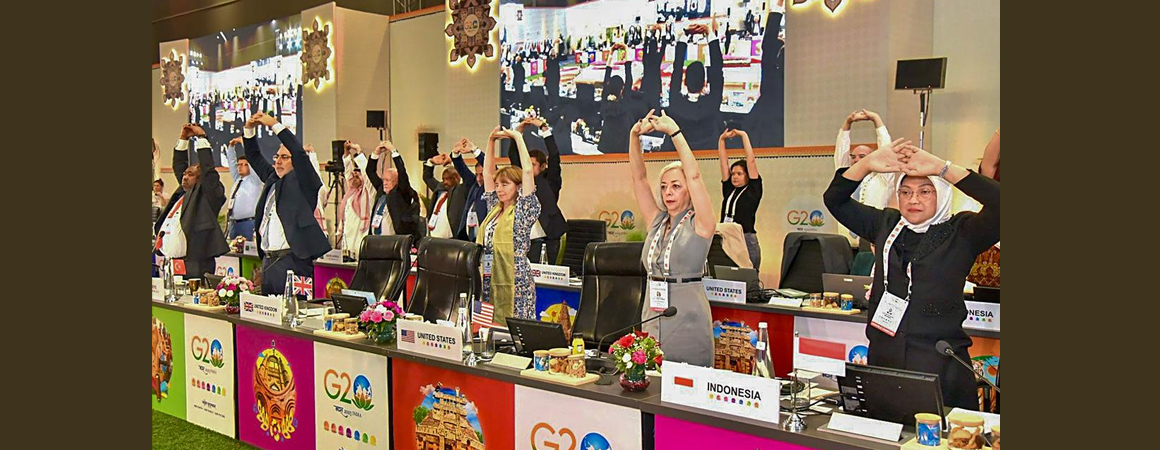Why has a single joint statement not been released so far at any G-20 Ministerial meeting? What is the bone of contention? What are the ‘Bali Paragraphs’ and why are they being incorporated in the current document? As G-20 President, what is India’s focus?
The story so far: With about 50 days to go until the G-20 Summit in New Delhi, Sherpas (senior members of the staff of the heads of state and government) and negotiators at various G-20 ministerial meetings and working groups have been unable to issue a single Joint Communiqué thus far. Instead, given the stand by Russia and China to oppose the paragraphs on the war in Ukraine contained in the statements that have been issued till now, India has been forced to issue a series of “Chairman’s Summary and Outcomes Documents” at the various meetings. These include the three meetings of the all-powerful G-20 Finance Ministers and Central Bank Governors, to ones on Tourism, Education, Labour, Crime and Digital Security and even the Space economy. Are there still chances of a Joint Communiqué or “Leaders Declaration” being issued at the G-20 Summit in India on September 9-10?
Why does a Joint Communiqué matter?
Since its inception in 1999, and upgradation to a leader’s level summit in 2008, the G-20 grouping of the world’s biggest economies has always managed to find a consensus within the countries and issue a joint declaration at the end of every summit. If that doesn’t take place in New Delhi this September, it would be an ignoble first for the grouping, and could even raise questions over whether the G-20 is sustainable in its present form. After the Russian annexation of Crimea in 2014, G-8 leaders had suspended Russia, changing the grouping to G-7. However, the G-20 summit in Brisbane, Australia that year managed to issue a joint declaration without mentioning the Crimean conflict, and even managed a “family photo” with all the leaders including Russian President Vladimir Putin. In 2022, the Indonesian G-20 presidency faced tense moments as the declaration was negotiated until the very last moment of the summit. Mr. Putin didn’t attend, and no “family photo” was allowed, but it managed to issue a document. During its tenure as President, India wishes for the best possible outcome at the G-20 summit, and hence its negotiators on the “Sherpa track”, who collate the final document, are putting sustained efforts into ensuring a resolution to the logjam over Ukraine.
Why has the current presidency continued with the ‘Bali Paragraphs’ in its documents?
Indian officials maintain that a lot of hard work went into the formulation of the “Bali Paragraphs”, and therefore they have been imported into India’s G-20 documents. They say the Bali formulation can be divided into three parts — the references to the United Nations Security Council (UNSC) and United Nations General Assembly (UNGA) resolutions “deploring” Russia’s war in Ukraine, which are from the UN and cannot be modified. Second, the statement that “most members” strongly condemned the war in Ukraine, refers to the International Monetary Fund (IMF) conventions for “qualifiers” where “most” means 62.5% or 12 of the 20 G-20 members. Third, the use of Prime Minister Modi’s phrase — “This era is not of war” — is universal and doesn’t refer to any one country or war. Meanwhile, the additional line that the G-20 is not a forum for security issues, but for economic issues arising from security concerns, like the impact of the Ukraine war on fuel, food and fertilizer prices, is unimpeachable.
The Indian Sherpa Amitabh Kant has also made it clear that developing countries did not create the Ukraine conflict, nor is the war India’s priority at the G-20. Instead, India wants to leave the intractable issues for the end, keeping the focus on the induction of the African Union as a member of the G-20, development goals, digital public infrastructure, gender-led empowerment, reform of multilateral development banks and other priorities.
Why are Russia and China opposing?
Russia and China oppose the language on Ukraine, even though it is taken from last year’s Bali G-20 document that they signed. Both the countries have now refused to endorse the “Bali Paragraph[s]” in every G-20 meeting under India’s presidency, albeit for different reasons. Russia says the language at Bali no longer holds true as it does not include increased U.S. and European military support to Ukraine, or the increased sanctions against Russia that followed. China has said that it doesn’t believe the G-20, essentially an economic forum, should discuss “geopolitical issues” as it hasn’t in the past two decades, indicating the Bali statement was an exception. An added problem could be the footnote by South Africa in the latest meeting of G-20 Labour Ministers in Indore which ended on Friday, that insists that “Sherpas have not concluded discussions” on the “Bali Paragraph[s]”, indicating that unless this is resolved soon, the issues over Ukraine may see more pushback from other countries to India’s hopes for a consensus. On the bright side, Russia, in the last two meetings, appears to have accepted the second, more generic paragraph from Bali that speaks about the problems of conflicts generally, indicating some progress.
What are the chances of a Joint Communiqué now?
With a number of ministerials including the 3rd Finance Ministers and Central Bank Governors meeting done, the Sherpa track will kickstart the draft “Delhi Declaration” negotiations from August 1, and try to nail all the areas of differences including U.S.-China tussles over debt sustainability, privacy issues over digital public infrastructure and so forth, and chip away at the most significant differences over the Ukraine war. Officials say, given the political nature of the Ukraine issue, as well as developments in the war on the ground changing the situation, there may be little point in finalising something that could get dated. As a result, until an alternative acceptable language is not hammered out, they have left a “placeholder” reference to “geopolitical issues” in the final G-20 Leaders Declaration document being prepared, while they finalise the rest of the document on other issues.
In addition, Indian negotiators have been taking suggestions from other countries including its two other “troika” colleagues: Indonesia, which hosted the G-20 in 2022, and Brazil that will host the G-20 in 2024. A draft circulated by Brazil in June that suggested acknowledging the Bali consensus and “moving on” from the Ukraine conflict was rejected, as was a longer Russian alternative draft. Much will now depend on the heavy lifting by leaders including Prime Minister Modi.
And all eyes will be on whether Mr. Modi undertakes travel to Russia and Ukraine as Indonesian President Jokowi did last year, or if he is able to make progress at the BRICS Summit at the end of August in Capetown, given Brazil-Russia-India-China-South Africa are all members of the G-20, not to mention, the last minute diplomacy he may have to exert closer to the G-20 Summit itself.
- The G-20 grouping of the world’s biggest economies has always managed to find a consensus within the countries and issue a joint declaration at the end of every summit.
- Indian officials maintain that a lot of hard work went into the formulation of the “Bali Paragraphs”, and therefore they have been imported into India’s G-20 documents.
- Officials say, given the political nature of the Ukraine issue, as well as developments in the war on the ground changing the situation, there may be little point in finalising something that could get dated.
Explained | Will G-20 agree on a Joint Communiqué?
Why has a single joint statement not been released so far at any G-20 Ministerial meeting? What is the bone of contention? What are the ‘Bali Paragraphs’ and why are they being incorporated in the current document? As G-20 President, what is India’s focus?
The story so far: With about 50 days to go until the G-20 Summit in New Delhi, Sherpas (senior members of the staff of the heads of state and government) and negotiators at various G-20 ministerial meetings and working groups have been unable to issue a single Joint Communiqué thus far. Instead, given the stand by Russia and China to oppose the paragraphs on the war in Ukraine contained in the statements that have been issued till now, India has been forced to issue a series of “Chairman’s Summary and Outcomes Documents” at the various meetings. These include the three meetings of the all-powerful G-20 Finance Ministers and Central Bank Governors, to ones on Tourism, Education, Labour, Crime and Digital Security and even the Space economy. Are there still chances of a Joint Communiqué or “Leaders Declaration” being issued at the G-20 Summit in India on September 9-10?
Why does a Joint Communiqué matter?
Since its inception in 1999, and upgradation to a leader’s level summit in 2008, the G-20 grouping of the world’s biggest economies has always managed to find a consensus within the countries and issue a joint declaration at the end of every summit. If that doesn’t take place in New Delhi this September, it would be an ignoble first for the grouping, and could even raise questions over whether the G-20 is sustainable in its present form. After the Russian annexation of Crimea in 2014, G-8 leaders had suspended Russia, changing the grouping to G-7. However, the G-20 summit in Brisbane, Australia that year managed to issue a joint declaration without mentioning the Crimean conflict, and even managed a “family photo” with all the leaders including Russian President Vladimir Putin. In 2022, the Indonesian G-20 presidency faced tense moments as the declaration was negotiated until the very last moment of the summit. Mr. Putin didn’t attend, and no “family photo” was allowed, but it managed to issue a document. During its tenure as President, India wishes for the best possible outcome at the G-20 summit, and hence its negotiators on the “Sherpa track”, who collate the final document, are putting sustained efforts into ensuring a resolution to the logjam over Ukraine.
Why has the current presidency continued with the ‘Bali Paragraphs’ in its documents?
Indian officials maintain that a lot of hard work went into the formulation of the “Bali Paragraphs”, and therefore they have been imported into India’s G-20 documents. They say the Bali formulation can be divided into three parts — the references to the United Nations Security Council (UNSC) and United Nations General Assembly (UNGA) resolutions “deploring” Russia’s war in Ukraine, which are from the UN and cannot be modified. Second, the statement that “most members” strongly condemned the war in Ukraine, refers to the International Monetary Fund (IMF) conventions for “qualifiers” where “most” means 62.5% or 12 of the 20 G-20 members. Third, the use of Prime Minister Modi’s phrase — “This era is not of war” — is universal and doesn’t refer to any one country or war. Meanwhile, the additional line that the G-20 is not a forum for security issues, but for economic issues arising from security concerns, like the impact of the Ukraine war on fuel, food and fertilizer prices, is unimpeachable.
The Indian Sherpa Amitabh Kant has also made it clear that developing countries did not create the Ukraine conflict, nor is the war India’s priority at the G-20. Instead, India wants to leave the intractable issues for the end, keeping the focus on the induction of the African Union as a member of the G-20, development goals, digital public infrastructure, gender-led empowerment, reform of multilateral development banks and other priorities.
Why are Russia and China opposing?
Russia and China oppose the language on Ukraine, even though it is taken from last year’s Bali G-20 document that they signed. Both the countries have now refused to endorse the “Bali Paragraph[s]” in every G-20 meeting under India’s presidency, albeit for different reasons. Russia says the language at Bali no longer holds true as it does not include increased U.S. and European military support to Ukraine, or the increased sanctions against Russia that followed. China has said that it doesn’t believe the G-20, essentially an economic forum, should discuss “geopolitical issues” as it hasn’t in the past two decades, indicating the Bali statement was an exception. An added problem could be the footnote by South Africa in the latest meeting of G-20 Labour Ministers in Indore which ended on Friday, that insists that “Sherpas have not concluded discussions” on the “Bali Paragraph[s]”, indicating that unless this is resolved soon, the issues over Ukraine may see more pushback from other countries to India’s hopes for a consensus. On the bright side, Russia, in the last two meetings, appears to have accepted the second, more generic paragraph from Bali that speaks about the problems of conflicts generally, indicating some progress.
What are the chances of a Joint Communiqué now?
With a number of ministerials including the 3rd Finance Ministers and Central Bank Governors meeting done, the Sherpa track will kickstart the draft “Delhi Declaration” negotiations from August 1, and try to nail all the areas of differences including U.S.-China tussles over debt sustainability, privacy issues over digital public infrastructure and so forth, and chip away at the most significant differences over the Ukraine war. Officials say, given the political nature of the Ukraine issue, as well as developments in the war on the ground changing the situation, there may be little point in finalising something that could get dated. As a result, until an alternative acceptable language is not hammered out, they have left a “placeholder” reference to “geopolitical issues” in the final G-20 Leaders Declaration document being prepared, while they finalise the rest of the document on other issues.
In addition, Indian negotiators have been taking suggestions from other countries including its two other “troika” colleagues: Indonesia, which hosted the G-20 in 2022, and Brazil that will host the G-20 in 2024. A draft circulated by Brazil in June that suggested acknowledging the Bali consensus and “moving on” from the Ukraine conflict was rejected, as was a longer Russian alternative draft. Much will now depend on the heavy lifting by leaders including Prime Minister Modi.
And all eyes will be on whether Mr. Modi undertakes travel to Russia and Ukraine as Indonesian President Jokowi did last year, or if he is able to make progress at the BRICS Summit at the end of August in Capetown, given Brazil-Russia-India-China-South Africa are all members of the G-20, not to mention, the last minute diplomacy he may have to exert closer to the G-20 Summit itself.
- The G-20 grouping of the world’s biggest economies has always managed to find a consensus within the countries and issue a joint declaration at the end of every summit.
- Indian officials maintain that a lot of hard work went into the formulation of the “Bali Paragraphs”, and therefore they have been imported into India’s G-20 documents.
- Officials say, given the political nature of the Ukraine issue, as well as developments in the war on the ground changing the situation, there may be little point in finalising something that could get dated.






NO COMMENT